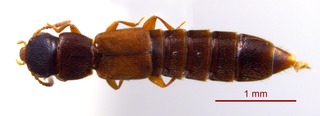
The rove beetles are a family (Staphylinidae) of beetles, primarily distinguished by their short elytra that typically leave more than half of their abdominal segments exposed. With over 66,000 species in thousands of genera, the group is one of the largest families in the beetle order, and one of the largest families of organisms. It is an ancient group that first appeared during the Middle Jurassic based on definitive records of fossilized rove beetles, with the Late Triassic taxon Leehermania more likely belonging to Myxophaga. They are an ecologically and morphologically diverse group of beetles, and commonly encountered in terrestrial ecosystems.

The Omaliinae are a subfamily of the Staphylinidae, rove beetles.

Pselaphinae are a subfamily of beetles in the family Staphylinidae, the rove beetles. The group was originally regarded as a separate family named Pselaphidae. Newton and Thayer (1995) placed them in the Omaliine group of the family Staphylinidae based on shared morphological characters.

Staphylinoidea is a superfamily of beetles. It is a very large and diverse group with worldwide distribution.

Pterolonchidae is a small family of very small moths in the superfamily Gelechioidea. There are species native to every continent except Australia and Antarctica.

The Paederinae are a subfamily of the Staphylinidae, rove beetles. As of 2024, three tribes are accepted within this subfamily: Lathrobiini, Paederini, and Pinophilini. This insect is commonly known as Tomcat.

Dasycerinae is a subfamily of rove beetles. Dasycerinae currently only contains 1 extant genus and 3 extinct genera.
The Empelinae are a subfamily of rove beetles; their biology is virtually unknown. Their anatomy and ecology resemble many rove beetles.

The Habrocerinae are a subfamily of the Staphylinidae, rove beetles.

The Oxytelinae are a subfamily of the Staphylinidae, rove beetles. There are about 20 genera and at least 320 described species in Oxytelinae.

Phloeocharinae is a subfamily of beetles in the family Staphylinidae.

Piestinae are a subfamily of Staphylinidae.

Many species of Staphylinidae have developed complex interspecies relationships with ants, known as myrmecophily. Rove beetles are among the most rich and diverse families of myrmecophilous beetles, with a wide variety of relationships with ants. Ant associations range from near free-living species which prey only on ants, to obligate inquilines of ants, which exhibit extreme morphological and chemical adaptations to the harsh environments of ant nests. Some species are fully integrated into the host colony, and are cleaned and fed by ants. Many of these, including species in tribe Clavigerini, are myrmecophagous, placating their hosts with glandular secretions while eating the brood.
Mipseltyrus is a genus of ant-loving beetles in the family Staphylinidae. There are at least 4 described species in Mipseltyrus.

Anthophagini is a tribe of ocellate rove beetles in the family Staphylinidae. There are at least 20 genera and 20 described species in Anthophagini.

Omaliini is a tribe of ocellate rove beetles in the family Staphylinidae. There are about 45 genera and 450 described species in Omaliini.
Cenaspis aenigma is a species of colubrid snake in the subfamily Dipsadinae and the only member of the monotypic genus Cenaspis. It is endemic to the highlands of western Chiapas, Mexico, where it was described from a single, partially digested male specimen found in the stomach of a Central American coral snake. This is referenced in its generic name, as cena is Spanish for "dinner". Despite being partially digested, the specimen still displayed many unique traits, including undivided subcaudals for the full length of the tail, as well as a simple hemipenis completely covered in calyces with a largely non-bifurcated sulcus spermaticus. These traits are not known from any other colubroid snake in the Western Hemisphere.
Peter Michael Hammond was a British entomologist who specialised in Coleoptera (beetles). For many years he was the head of the Coleoptera section at the Natural History Museum, London.
Artochia is a genus of rove beetles in the family Staphylinidae, subfamily Omaliinae.
Diochini is a tribe of rove beetles in the family Staphylinidae. There are at least 2 genera and 84 described species in Diochini.













